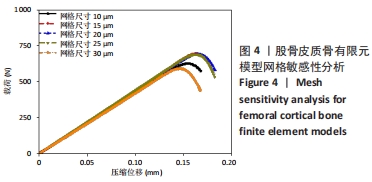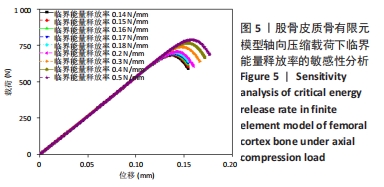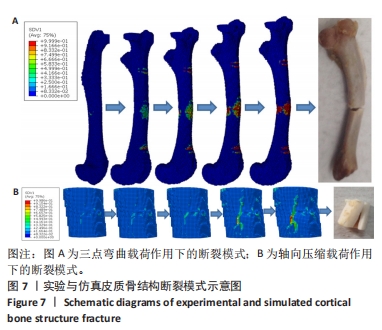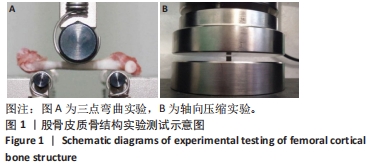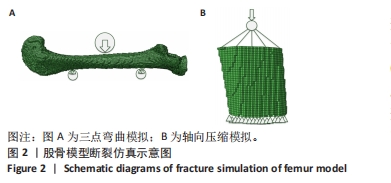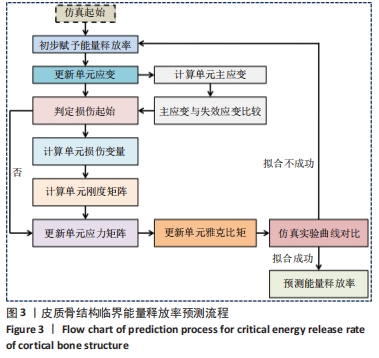中国组织工程研究 ›› 2024, Vol. 28 ›› Issue (36): 5779-5784.doi: 10.12307/2024.694
• 数字化骨科Digital orthopedics • 上一篇 下一篇
不同失效模式下皮质骨结构临界能量释放率预测
范若寻1,2,王溢童1,贾政斌3
- 1扬州工业职业技术学院,交通工程学院,江苏省扬州市 225000;2吉林化工学院,航空工程学院,吉林省吉林市 132022;3吉林大学,机械与航空航天工程学院,吉林省长春市 130025
Prediction of critical energy release rate for cortical bone structure under different failure modes
Fan Ruoxun1, 2, Wang Yitong1, Jia Zhengbin3
- 1School of Traffic Engineering, Yangzhou Polytechnic Institute, Yangzhou 225000, Jiangsu Province, China; 2School of Aerospace Engineering, Jilin Institute of Chemical Technology, Jilin 132022, Jilin Province, China; 3School of Mechanical and Aerospace Engineering, Jilin University, Changchun 130025, Jilin Province, China
摘要:
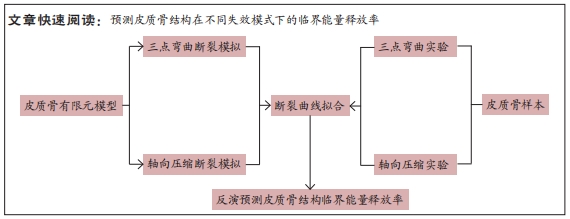
文题释义:
失效模式:具体指骨结构的断裂模式。骨结构可能会承受来自不同方向的不同类型载荷,当外界载荷超过骨结构强度极限时,骨结构将发生失效。不同类型的载荷可能会导致不同的失效模式,如弯曲失效、拉伸失效、扭转失效等,均为骨结构常见失效模式。临界能量释放率:指结构在破坏过程中可测得的一个全局断裂力学参数,其数值是多个裂纹扩展以及塑性或脆性破坏机制共同作用的结果。当结构裂纹起始损伤中产生的能量释放率超过临界值时,裂纹继续扩展。
背景:临界能量释放率是结构在破坏过程中可测得的一个全局断裂力学参数,即使针对同一结构,在不同失效模式下其数值也可能存在差异。
目的:提出一种方法预测皮质骨结构在不同失效模式下的临界能量释放率。方法:针对大鼠股骨皮质骨结构进行三点弯曲与轴向压缩实验以及相应断裂仿真。通过对有限元模型赋予不同临界能量释放率进行断裂模拟,并将每次模拟所得载荷-位移曲线与实验数据进行比较,当仿真与实验所得断裂参数差异小于5%时,即代表拟合成功,以此反演预测皮质骨结构在不同失效模式下的临界能量释放率。
结果与结论:①结果显示大鼠股骨皮质骨结构在三点弯曲载荷下主要发生拉伸破坏,该失效模式下所预测临界能量释放率为0.16 N/mm;②在轴向压缩载荷下主要发生剪切破坏,所预测临界能量释放率为0.12 N/mm,这说明同一皮质骨结构在不同失效模式下的临界能量释放率存在差异;③此文通过对结构力学性能与损伤机制进行综合分析,揭示了不同失效模式下皮质骨结构临界能量释放率存在差异的原因,为能量释放率测量以及准确的皮质骨断裂模拟提供理论依据。
https://orcid.org/0000-0002-1604-2489 (范若寻)
中国组织工程研究杂志出版内容重点:人工关节;骨植入物;脊柱;骨折;内固定;数字化骨科;组织工程
中图分类号:
